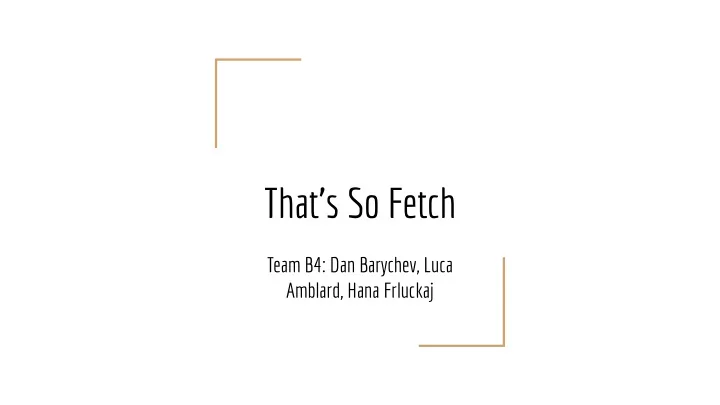

That’s So Fetch Team B4: Dan Barychev, Luca Amblard, Hana Frluckaj
Use Case Want a puppy? Allergic? Problem solved! ● This toy simulates playing fetch with a dog. Using user-worn motion ● detectors, our device will calculate and anticipate the object thrown, recieve it, and bring it back to the user. To replace the irreplaceable bond between man and man’s best friend. ○ Areas: Software, Signals, Circuits ●
Requirements Process Specs Success rate, measured by # balls thrown vs. # balls received > 50% User ball throwing range (distance between user and device) 2m radius Device feasible retrieval range 1m radius Device basket 25cm diameter Projected (prethrow) angle vs. actual angle < 5% Tilting reaction time to prethrow < 3 s IMU-Motor communication latency (standard Bluetooth delay) < 200 ms Once ball is caught, drive back to user < 5s
Previous Projects Minoru Kurata - Smart Trashbox ● Team B4 before B4 ● (Smart Trash Can F19) ○ Previous projects present “smart” trash ● Dependent on CV and have no more than a ○ 50% success rate Our project will strive for a catch system ● entirely powered by motion capture through IMUs
Solution Approach - Woof Dog simulator: ● Metal chassis with 5 motors, an ○ IMU, motion sensor, and a basket/lid 4 motors for wheels (possibly ○ omnidirectional), 1 motor to tilt basket Motion sensor used for closing ○ basket lid IMU used for following thrower ○ after catch
Solution Approach - Hand 5+ IMUs placed on throwing arm ● 2+ on hand, 1 on wrist, 1 on elbow, ○ one 1 shoulder Arm IMUs provide the angle, ● acceleration, and beginning position of the ball Applying common physics ● parabolic equations allows us to estimate the ball’s terminal position and angle of impact.
Solution Approach (Cont.) IMUs communicate via WIFI to an ● NVIDIA Jetson on dog device WIFI has a smaller latency than Bluetooth ○ (150ms compared to 200ms) Once user begins prethrow, device ● moves up to 1m in throw direction IMUs on fingers convey ball release ● and Jetson computes the arrival The vehicle’s rotary encoders, through ● a PID control system, guide the device to ball and tilt the basket accordingly
Solution Approach (Cont.) Once the ball enters the basket, ● motion sensor at the top of the basket tells the lid on top of the basket to close. Basket then tilts upright. The vehicle, combining its IMU ● data with its starting position, drives back to the user and opens the lid. The throw cycle then repeats
Solution: Architecture Diagram Jetson Nano User’s Arm Wifi Wifi NIC Target Location IMUs transmitter module Estimation Position IMU Tracking PID Control Motor Encoder Controller Motors
Testing Verification and Metrict Execute pre-throw and ensure robot moves 1m away at the expected ● angle (5% error allowed). Angle measured using large protractor. Latency of IMU data transmission from user arm to Jetson Nano. ● Mapping of IMU data to target location ● Ensure distance between target location and landing location of the ball < 12.5 cm radius ○ Ensure the robot travels to target location with enough speed and ● accuracy to catch the ball. Throw ball in various locations within 1m from the robot ○ Calculate catch success rate and ensure it is at least 50% ○
Key Challenges Connectivity and Latency over Wifi ● Estimating the landing location of the ball using IMU data ● Control system design to reach the target location ● Reactive speed of dog device ● Reacting to prethrow ○ Tilting to anticipate ball arrival angle ○ Enclosing ball to prevent bouncing out ○
Schedule
Recommend
More recommend